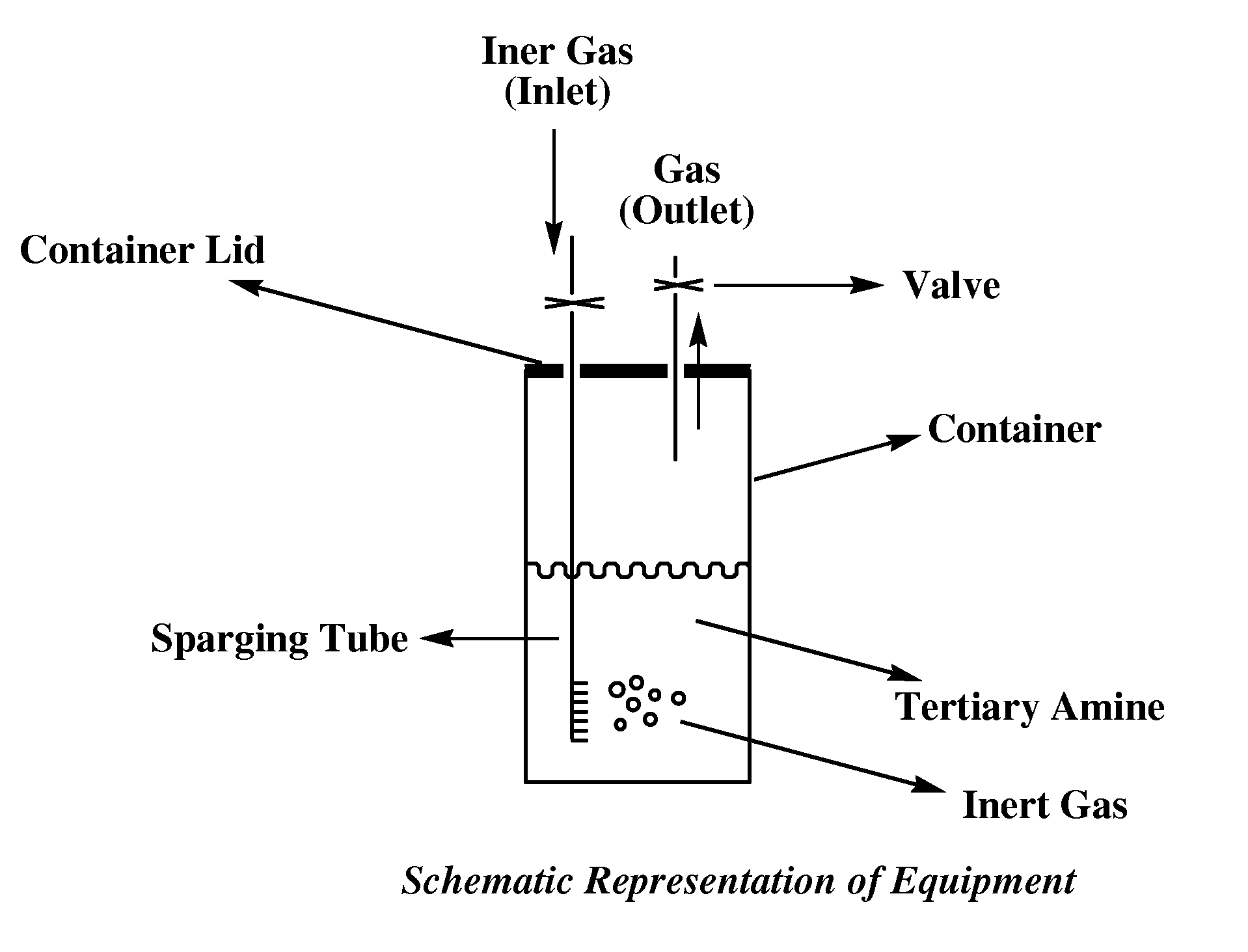Tertiary amine composition and method for making the composition
a technology of tertiary amine and composition, which is applied in the direction of organic compound/hydride/coordination complex catalyst, physical/chemical process catalyst, amino compound purification/separation, etc., can solve the problems of prohibiting cost, requiring extensive labor and time, and being difficult to achieve, so as to achieve simple and cost-effective solutions, prevent formation or reduction of concentration, and effect on the long-term stability and quality of tertiary amine catalys
- Summary
- Abstract
- Description
- Claims
- Application Information
AI Technical Summary
Benefits of technology
Problems solved by technology
Method used
Image
Examples
example 1
Tertiary Amine Compositional Changes with Time when the Tertiary Amine is Stored in Equilibrium with a Headspace Volume Composed of Atmospheric Air
[0056]The model tertiary N,N,N′-trimethyl-N′-3-aminopropyl-bis(aminoethyl)ether(amine-1) was selected for this study because this compound is widely used as a blowing catalyst in many commercial applications. The catalyst is a blowing polyurethane catalyst commonly used in flexible molded and flexible slabstock applications where chemical emanation is of great concern. However, the catalyst is also employed in many other used such as rigid, semi-rigid, spray and any other application where water may be used to blow the polyurethane polymer. In this example, 19 ml of amine-1 was placed in a 25 ml vial and the amine liquid phase was conditioned at 55° C. with the remaining 6 ml of the vial occupied by atmospheric air in equilibrium with the liquid amine phase. The vial was open after 15 days to take a sample for analysis (sample #1). The vi...
example 2
Tertiary Amine Compositional Changes with Time when the Tertiary Amine is Stored in Equilibrium with a Headspace Volume Composed of a Nitrogen Enriched Atmosphere
[0057]Amine-1 (19 ml) was placed in a 25 ml vial and the liquid was flushed with nitrogen for 15 minutes until the 6 ml head space (gaseous volume in contact with the liquid tertiary amine) was depleted of oxygen. The composition was allowed to reach equilibrium once the vial containing the amine was tightly sealed under a slight positive pressure of nitrogen. The vial was open after 15 days to take a sample for analysis (sample #3). The vial was closed and reconditioned at 55° C. for an additional 15 days after which a second sample was taken for analysis (sample #4).The result shows that some increase in the concentration of formaldehyde and DMF is still observed but the final concentration of DMF and formaldehyde is significantly lower than in example 1 where the sample was allow to reach equilibrium under air. Thus, exa...
example 3
Tertiary Amine Compositional Changes with Time when the Tertiary Amine is Stored in Equilibrium with a Different Headspace Volume Composed of Atmospheric Air
[0058]Amine-1 was placed in a vial and the volume of the headspace having atmospheric air in equilibrium with the amine phase was varied to see the effect that a larger amount of oxygen on the headspace would have on the concentration of DMF and formaldehyde as the sample is conditioned at 55° C. over a long period of time. The results shown in table 3 illustrates that a sample in equilibrium with more air for 20 days had more DMF and formaldehyde than a sample conditioned for 39 days with less air (<6 ml air). This example illustrates that the amount of oxygen present on the headspace plays a role on the final concentration of DMF and formaldehyde in the liquid phase. A headspace composed mainly of nitrogen or an inert gas result in little or no appreciable change in the concentration of DMF and formaldehyde.
TABLE 3Formaldehyde...
PUM
| Property | Measurement | Unit |
|---|---|---|
| Partial pressure | aaaaa | aaaaa |
| Partial pressure | aaaaa | aaaaa |
| Partial pressure | aaaaa | aaaaa |
Abstract
Description
Claims
Application Information
 Login to View More
Login to View More - R&D
- Intellectual Property
- Life Sciences
- Materials
- Tech Scout
- Unparalleled Data Quality
- Higher Quality Content
- 60% Fewer Hallucinations
Browse by: Latest US Patents, China's latest patents, Technical Efficacy Thesaurus, Application Domain, Technology Topic, Popular Technical Reports.
© 2025 PatSnap. All rights reserved.Legal|Privacy policy|Modern Slavery Act Transparency Statement|Sitemap|About US| Contact US: help@patsnap.com


